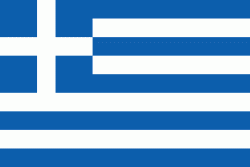Heraklion International Airport (Heraklion International Airport)
Heraklion International Airport "Nikos Kazantzakis" is the primary airport on the island of Crete, Greece, and the country's second busiest airport after Athens International Airport. It is located about 5 km east of the main city centre of Heraklion, near the municipality of Nea Alikarnassos. It is a shared civil/military facility. The airport is named after Heraklion native Nikos Kazantzakis, a Greek writer and philosopher. Nikos Kazantzakis Airport is Crete's main and busiest airport, serving Heraklion (Ηράκλειο), Aghios Nikolaos (Άγιος Νικόλαος), Malia (Mάλλια), Hersonissos (Χερσόνησος), Stalida (Σταλίδα), Elounda (Ελούντα) and other resorts.
A new airport for Heraklion, located 39 km to the south-east of the city at Kasteli, is under construction and due to open by 2026. Once completed, the new Kasteli International Airport will replace the current Heraklion International Airport as the hub for central Crete.
The airport first opened in March 1939. This was then merely a piece of flat agricultural land. The first aeroplane (a Junkers Ju 52) carried the first passengers to the site. During the Second World War, the airfield was the site of the Battle of Heraklion, during the Battle of Crete in 1941. Civilian operations ceased, but in the autumn of 1946 traffic resumed, introducing the DC-3 aircraft.
At first, the airport only offered very basic service, with only primitive installations on the site, in the form of three tents, smoke for wind determination and storm lamps for runway lighting.
In 1947, the first (small) terminal was erected. Hellenic Airlines started commercial flights in 1948. At that time, a total of 4,000 people were served. The year 1953 saw the construction of a paved runway which was initially 1,850 meters long and oriented as 09/27. The next major event followed in 1954, when a four-engined DC-4 aircraft landed for the first time at the airport. In that year the airport handled approximately 18,000 passengers. From 1957 onward, the new Olympic Airways used the airport, starting services with the DC-6 aircraft.
From 1968 until 1971, the runway was extended to 2,680 meters and a new terminal and other facilities were constructed, essentially making it a new airport. On March 18, 1971, the first charter flight from abroad (British Airways) operated at the airport. The new airport itself was officially inaugurated on May 5, 1972.
The airport is scheduled to cease operations in 2025 and to be replaced by the (by then expanded and renamed) Kasteli Airport.
A new airport for Heraklion, located 39 km to the south-east of the city at Kasteli, is under construction and due to open by 2026. Once completed, the new Kasteli International Airport will replace the current Heraklion International Airport as the hub for central Crete.
The airport first opened in March 1939. This was then merely a piece of flat agricultural land. The first aeroplane (a Junkers Ju 52) carried the first passengers to the site. During the Second World War, the airfield was the site of the Battle of Heraklion, during the Battle of Crete in 1941. Civilian operations ceased, but in the autumn of 1946 traffic resumed, introducing the DC-3 aircraft.
At first, the airport only offered very basic service, with only primitive installations on the site, in the form of three tents, smoke for wind determination and storm lamps for runway lighting.
In 1947, the first (small) terminal was erected. Hellenic Airlines started commercial flights in 1948. At that time, a total of 4,000 people were served. The year 1953 saw the construction of a paved runway which was initially 1,850 meters long and oriented as 09/27. The next major event followed in 1954, when a four-engined DC-4 aircraft landed for the first time at the airport. In that year the airport handled approximately 18,000 passengers. From 1957 onward, the new Olympic Airways used the airport, starting services with the DC-6 aircraft.
From 1968 until 1971, the runway was extended to 2,680 meters and a new terminal and other facilities were constructed, essentially making it a new airport. On March 18, 1971, the first charter flight from abroad (British Airways) operated at the airport. The new airport itself was officially inaugurated on May 5, 1972.
The airport is scheduled to cease operations in 2025 and to be replaced by the (by then expanded and renamed) Kasteli Airport.
| IATA Code | HER | ICAO Code | LGIR | FAA Code | |
|---|---|---|---|---|---|
| Telephone | +302810397800 | Fax | +302810221700 | ||
| Home page | Hyperlink |
Map - Heraklion International Airport (Heraklion International Airport)
Map
Country - Greece
 |
 |
| Flag of Greece | |
Greece is considered the cradle of Western civilization, being the birthplace of democracy, Western philosophy, Western literature, historiography, political science, major scientific and mathematical principles, theatre and the Olympic Games. From the eighth century BC, the Greeks were organised into various independent city-states, known as poleis (singular polis), which spanned the Mediterranean and the Black Sea. Philip II of Macedon united most of present-day Greece in the fourth century BC, with his son Alexander the Great rapidly conquering much of the ancient world, from the eastern Mediterranean to the North Western parts of India. The subsequent Hellenistic period saw the height of Greek culture and influence in antiquity. Greece was annexed by Rome in the second century BC, becoming an integral part of the Roman Empire and its continuation, the Byzantine Empire, which was culturally and linguistically predominantly Greek.
Currency / Language
| ISO | Currency | Symbol | Significant figures |
|---|---|---|---|
| EUR | Euro | € | 2 |
| ISO | Language |
|---|---|
| EN | English language |
| FR | French language |
| EL | Greek language |















